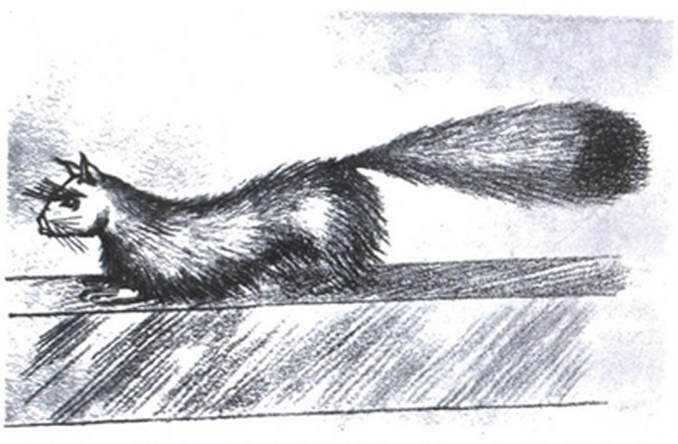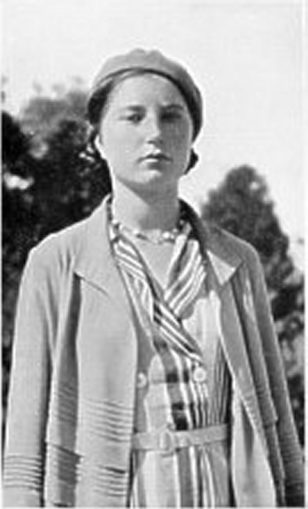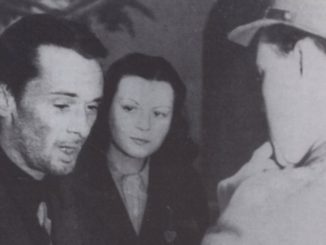
Harry Price and Richard Lambert, Public domain, via Wikimedia Commons
James Irving was….Well, even at this early juncture in our story the sources are ambiguous and contradictory. Said to have been a prosperous Liverpudlian businessman, the nature of his business is variously described as a wholesale retailer and distributor of musical instruments, the proprietor of a modest music shop or as a humble piano tuner.
Be that as it may, in 1916 James Irving decided, for reasons of his own, to leave Liverpool behind and become a farmer on the Isle of Man. To this end he bought the farm house and its associated acres and stock at Cashen’s Gap, a mile or so outside the village of Dalby. By the end of the year James and his wife Margaret were ensconced there, far away from the hustle and bustle of city life.
If Jim Irving had indeed wanted to get away from it all, he could not have chosen a better spot. Although Man is too small and densely populated an island to allow for any real degree of isolation, Cashen’s Gap offered a pretty fair facsimile thereof. Situated a five hundred yards climb up a steep hillside from the nearest road, the old grey house commanded views across St Patrick’s Channel to Ireland in the west and to the Scottish coast of Galloway looking northwards.
The farmhouse had no gas or electricity, the only illumination came from oil lamps or candles and the only heat from wood or turf burning in the open fireplace. The interior of the house was panelled in wood throughout, which stood on battens four inches proud from the stone walls and acted as insulation, which must have been a blessing when the winter winds came roaring in from the North Atlantic and the old place felt like it was at the ends of the Earth.
The Irvings seem to have settled down quite nicely into their new life. A daughter was born to them who they named Voirrey, which is the Manx version of Mary. The child attended the local schools and they made friends in the community, and they eased into an untroubled bucolic routine.
Until, that is, one day in 1931 when they noticed a small, unusual looking animal hanging around the farmyard. It was about the size of a small rat, but with yellowish fur and a bushy tail. It was a wary and fugitive creature and the Irvings only ever caught fleeting glimpses, but as far as they could tell it looked like nothing so much as a mongoose. And it seemed to have, instead of front paws, oversized appendages which resembled human hands.
A few days later the creature, whatever it was, seemed to have got inside the Irving’s house. There were the noises of scampering and scratching from behind the panelling, and the animal gave forth a variety of high pitched squeaks and spitting and blowing sounds.
Jim decided to get rid of it, so he put down poison which the little critter studiously ignored, and traps which it evaded. He tried all-night stakeouts with his .22 rifle but, short of randomly blowing holes in the wainscotting, his unwelcome guest was too wise to present him with anything remotely like a decent target.
Finally Jim tried psychological warfare. Hoping to scare the varmint away by pretending to be a dog, he knelt down by the panelling and loudly said ‘Woof! Woof!’ There was a pause, and then a scratchy, high pitched voice only a few inches away from his ear said ‘Woof! Woof!’ in reply.

Harry Price and Richard Lambert, Public domain, via Wikimedia Commons
Throughout all of this Jim Irving comes across as a benign, unruffled sort of chap, and one with no shortage of time on his hands either. Certainly he was charmed by the little creature’s mimicry, and within a few days had taught it to moo like a cow, baa like a sheep and meow like a cat. He called it Jack and began leaving scraps of food out for it, which would vanish when nobody was looking. After a few more days, Jack would make the appropriate animal noise on a verbal command. He also began babbling like a baby, or like a toddler trying to form its first words
Mrs Irving and Voirrey also took to Jack. One day, not long after, Voirrey began singing a nursery rhyme to whatever it was that was racketing around behind the panels. After the fourth or fifth repetition of the simple verse she was rather surprised when the reedy, raspy little voice joined in, quite clearly and distinctly. A few days later when she called out ‘Make a noise like a cow, Jack’, the shrill tones replied ‘My name’s not Jack, it’s Gef!’
Once Gef started talking, his vocabulary emerged seemingly fully formed. Within weeks he was debating theology and politics with James, who was a man of some erudition himself. Gef also knew other languages or at least a few words of other languages, for here again the records are contradictory.
French, German, Russian, Spanish, Yiddish and Hebrew are some of the languages that Gef had at least a nodding acquaintance with. One could here note that glossolalia, or ‘speaking in tongues’, is a common phenomenon in cases of religious enthusiasm or demonic possession; the idea being that the person so afflicted becomes fluent in languages which they have previously had no knowledge of. One could also note that upon rigorous investigation, these utterances invariably turn out to be gibberish.
Furthermore one could also point out that in a busy seaport such as Liverpool at the height of the Victorian era of mercantile trade, scraps of all these languages and more could have been picked up from the polyglot crews who disembarked from the endless stream of ships putting into harbour.
Gef also liked to sing. He knew the Manx national anthem and a selection of hymns, as well as Spanish and French folksongs. He also knew a version of Home On The Range which was said to be bawdy in the extreme. The first time he sang it within hearing of Mrs Irving, she was so shocked that she said ‘Gef! You’re no animal!’ which strikes one as a little curious under the circumstances. ‘Of course not!’ replied Gef ‘I’m the Holy Ghost!’ Which is even more odd, when you think about it.
In fact what Gef had to say about himself is worth a look. On one occasion he said he was merely ‘an extra, extra clever little Mongoose’, but on another he said ‘I’ll split the atom! I am the fifth dimension! I am the eighth wonder of the world!’ But the first time he was asked this question, Gef replied ‘I am a ghost in the form of a weasel. I will haunt you.’
And Gef also once said of himself ‘I am a freak! I have hands and feet! If you could see me you’d be ossified, petrified, mummified and turned into a pillar of salt!’ Old Gef could bombast out a blank verse which, if not Shakespeherian, can be fairly said to be Marlovian.
Gef did once say that he had been born in Dehli, India in June 1852 which begs the question of how he got to the Irvings’ house, as mongooses (please note correct use of the plural) are not indigenous to the Isle of Man, and hereby hangs another interesting little snippet.
It is said that in 1912, or in 1890, a previous owner of the Irvings’ farm, or the owner of one nearby, introduced three pairs of mongooses onto his land in an effort to keep the rabbits down. The mongooses did not thrive in the harsh Manx winters, and were assumed to have died out within a year or two. Still, quite the coincidence though.
Gef also had a complex personality, mercurial even. He could be cheeky, and he once called Jim Irving a ‘fat-headed gnome’. He behaved very affectionately to Voirrey, slept in her bedroom and would follow her about the farmyard and on her walks in the country.
Hs relationship with Mrs Irving was a little more ambiguous though. He could be polite and affectionate, but on occasion he would pelt her from behind the paneling with small pebbles. One night he crept into her bed and whispered into her ear ‘I like you, Margaret, and I want you to like me’.
Mrs Irving was understandably a bit perturbed by this and immediately fled to Voirrey’s bedroom, where they were joined by Mr Irving who had been alerted by the racket. As they huddled there in the darkness, a series of heavy blows struck the other side of the bedroom door as if Gef was hurling himself at it in a blind rage.
Gef didn’t often lose his temper, but when he did he would disappear for a few days afterwards and then reappear as if nothing had happened. But it has to be said that Gef was in general a very helpful and amusing little mongoose. He would keep an eye on things and let the family know if somebody was approaching the house, or if a stray dog was roaming on their land. And he frequently brought home rabbits for the pot, which was always appreciated.

AnonymousUnknown author, Public domain, via Wikimedia Commons
Word of Gef’s existence spread, first on Man where the local press took up the story and then to the mainland with an article in the Manchester Guardian. There was a public appetite for this sort of thing and the Dalby Spook, as the case was known, became a national cause celebre.
There had been a resurgence of popular interest in spiritualism and the occult in the years after the First World War, as a bereaved and traumatised nation sought meaning and comfort in questionable metaphysics. Two short stories by Kipling are worth reading in this context: ‘The Gardener’ and ‘A Madonna Of The Trenches’. The latter is also a particularly effective ghost story, and both vividly portray the psychological landscape of grief and dislocation of the immediate post-war years.
The Dalby Spook aroused a great deal of controversy and partisanship. Richard Lambert, editor of the BBC magazine ‘The Listener’, was a passionate advocate for Gef’s existence. Sir Cecil Levita, a fellow board member, was not and called Lambert a blithering idiot and said that his gullibility rendered him unfit to hold his position. Lambert sued him, won and was awarded £7600 in damages, a not inconsiderable sum in those days.
The Irvings do not seem to have courted publicity, nor do they seem to have financially benefitted from it. And in time, as the stream of journalists and gawkers making their way up the muddy track to the farmhouse showed no sign of abating, they came to resent it. So Jim took the step of enlisting the help of the original Ghostbuster, Harry Price.
Price was a professional skeptic who had made a successful career out of exposing fraudulent mediums and the like. He had made his name by debunking the ‘spirit photography’ of Eva Carriere in 1905. Although these pictures look risibly obvious fakes today, they were the cutting edge of image manipulation at their time and Price had cemented his reputation for scrupulous and scientific investigation.
As it happens, Gef’s appearances at Cashel’s Gap were beginning to dwindle at the time that Price became involved. And despite investing a considerable amount of time and effort, Harry was unable to find sufficient evidence to prove or disprove fraud on the part of the Irvings, and after a couple of weeks he stumped off down the muddy track muttering sourly under his breath.
Price later published an account of the affair, in which he was careful to exonerate the Irvings from conscious fraud but tactfully suggested that the adolescent Voirrey might subconsciously be creating the phenomenon using ventriloquism. Price also suggested that the paneling in the house might work as sound ducts, thus accounting for Gef’s ability to speak from within different rooms without seemingly having the time to move between them.
This is of course nonsense. Even the most proficient ventriloquist cannot “throw his voice” to make it seem as though it is coming from any distance away from him. Acoustics do not work like that. Without a concealed system of microphones, amplifiers and speakers this is impossible.
Admittedly such technology did exist in a crude form in the Thirties, but as the house at Cashel’s Gap did not have electricity this is a non-starter. Ditto Price’s notion of the wainscot channeling Voirrey’s voice to different rooms. The panels were fixed to the walls on vertical battens, which would in effect have created a series of sealed chambers rather than a labyrinth of tunnels through which Voirrey could have directed her voice to this or that location at will.
Price was also shown a rabbit which, the Irvings said, had been killed by Gef and left by him for their dinner. Price said that the rabbit ‘bore clear signs of strangulation’. This is a curious point, which seems to have been overlooked by researchers.
As any countryman will tell you, there are two ways to take a rabbit. If you don’t mind people knowing you’re about, you shoot it and gunshot wounds are unmistakable. If you’re on the QT, you set snares. I should imagine that they have been banned now, but a snare is a running loop with the blank end staked into the ground. As the snare is made from wire or fishing line, the rabbit’s attempts to free itself cause the snare to lacerate the flesh around the neck, causing considerable blood loss. To the uninitiated these wounds make look as though some predator had gashed the animal’s neck.
If you ever must kill an animal do so for reasons other than your own gratification, and do it as quickly and as cleanly as possible.
But strangulation? One assumes that Price meant that there were no visible wounds or major loss of blood, bar perhaps a trickle from mouth or nostrils. Perhaps there was no more visible sign than a protruding tongue or staring eyes.
Of course a human could easily strangle a rabbit, but I defy you to get within arm’s reach of a wild rabbit much less grab one. But for a stealthy and wily predator with disturbingly human-looking prehensile front paws…?

Harry Price and Richard Lambert, Public domain, via Wikimedia Commons
Gef stopped visiting the Irvings, or perhaps the Irvings stopped talking about him. The furore died down, and life at Cashel’s Gap faded back into obscurity.
Jim Irving died in 1945, and the family sold up and moved back to the mainland. The farm was bought by a Mr Leslie Graham who some sources identify as the actor of the same name, although this does not seem likely.
Mr Graham bought the farm at a knock-down price, due to its reputation as being haunted. A few years later, when he may have been considering selling the place on, he announced that he had shot and killed Gef. However as the evidence that he laid before the world to support his claim was a bedraggled little bundle of black and white fur, rather than yellowy-brown, this can be taken with a pinch of salt.
Chashell’s Gap farm was demolished in 1970 and nothing has been rebuilt on the site, the gales still roll in from the Atlantic and on a clear day you can make out land to the east and north across the sea. And there, it seems, the matter rests. For now, at least.
In the copious annals of this sort of thing, which for the sake of argument we will call Paranormal Phenomena, Gef stands as unique for a number of reasons. For example, when a poltergeist manifests itself it may move furniture about or throw small objects about the place, and that is all it will ever do. Similarly yetis lurk around the tree line in frigid climatic zones, leaving footprints and posing for the occasional ambiguous photograph. There is a strong stock character feel to all these manifestations: they all behave precisely as you would expect them to and in this respect they never disappoint.
But Gef is in many respects very different. Note that he quite clearly seemed to evolve; from feral to semi-domesticated, and from purely vocal to articulate and lucid. To put it simply he developed an individual consciousness and a personality. He grew.
© bobo 2021
The Goodnight Vienna Audio file



